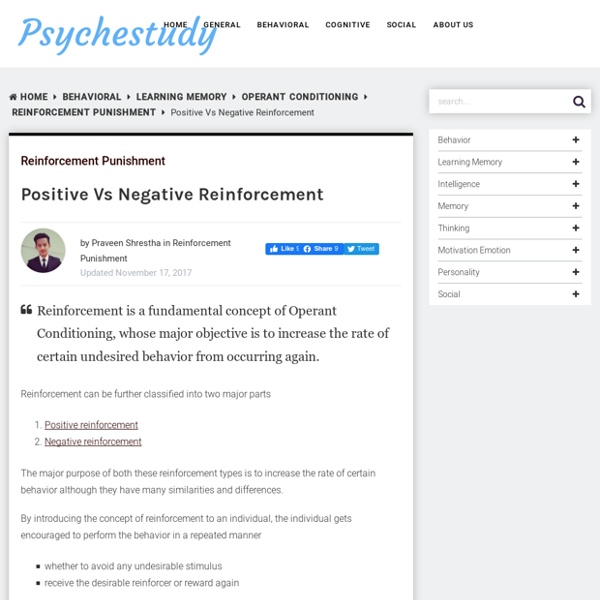4 Proven Behavior Modification Techniques with Examples
Behavior modification is a means of changing behavior through various techniques used to replace undesirable behaviors with desirable ones. Behavior modification techniques have been used to treat both adults and children for various problems, such as enuresis (bedwetting), separation and general anxiety, various phobias, obsessive-compulsive disorder (OCD), etc. The methods use vary, but usually involve some form of positive or negative reinforcement.
Positive vs Negative Punishment
Punishment is a fundamental concept of Operant Conditioning, whose major objective is to decrease the rate of certain undesired behavior from occurring again. Punishment can be further classified into two major parts These two different types of punishment have got both similarities and differences, as the major purpose of both these punishment types is to decrease the rate of certain undesired behavior. By introducing the concept of punishment to an individual, the individual gets the idea that what he/she is doing, is wrong. Positive and negative punishment, generally speaking, is the concept of adding certain unfavorable consequence or depriving the individual of certain favored item or advantage, in order to decrease the behavior.
Positive Reinforcement and Examples - Psychology
Positive reinforcement is a preferred disciplinary strategy in positive parenting because this method doesn’t involve aversive measures or punishment. However, this method doesn’t always work the way we think. Let’s find out what positive reinforcement is, its applications in everyday life and the best way to use it. What Is Positive Reinforcement? In operant conditioning, positive reinforcement aims to increase desired behavior by adding a favorable stimulus right after that behavior occurs. It is rewarding someone for what they do, and this reward encourages them to do it again.
Punishment in Psychology
Punishment is a term used in operant conditioning to refer to any change that occurs after a behavior that reduces the likelihood that that behavior will occur again in the future. While positive and negative reinforcements are used to increase behaviors, punishment is focused on reducing or eliminating unwanted behaviors. Punishment is often mistakenly confused with negative reinforcement.
Article 2
By the time children have reached adolescence, their responses are often ingrained, but parental actions can still positively affect adolescent behavior. Since adolescents are struggling to develop their personal identity and are concerned about their body image, parental support is crucial to help positively frame experiences as learning opportunities. Positive reinforcement remains a powerful teaching tool during these formative years, and we encourage parents to take time to contemplate the ways they can help adolescents mature and become self-reliant. Reinforce mature decisions by allowing increased privileges when adolescent demonstrates increased responsibility. For instance, an adolescent who consistently demonstrates the ability to come home at the requested time might be allowed a later curfew - whereas an adolescent who has not completed requested chores will not be allowed to leave home that evening.Express pleasure at positive adolescent behavior.
10 Normal Teenage Behavior Problems And How To Handle Them
Image: iStock Understanding Teenage Behavior Problems Dealing with a teenager is not easy. No matter how good a parent you are, and how great your relationship with your children is, you are likely to face parenting roadblocks when it comes to your teenager. Behavior problems are common in teenagers. But you can deal with them with ease if you are willing to put in the effort to understand what they are going through and what it is that they expect of you.
(Positive Reinforcement) Certificate of Merit. What is it? And how can you get one?
Getting a driver’s licence ensures that you are qualified to drive. But along with that comes the responsibility of making sure you drive safely, not just for your sake but also for the sake of other road users. To ensure that drivers are aware of this and keep safety uppermost on their minds while driving, the Traffic Police has instituted a system of rewards and punishments.
Negative Reinforcement and Operant Conditioning
Did you know that parents could train their children to act defiant? “Who in their right minds would do that?” you may wonder. Well, many of us actually do. Find out how a lot of parents unknowingly train their children in rebellion using negative reinforcement. Behavioral psychologist, B.F.
Reinforcement in Psychology 101 at AllPsych Online
Reinforcement The term reinforce means to strengthen, and is used in psychology to refer to anything stimulus which strengthens or increases the probability of a specific response. For example, if you want your dog to sit on command, you may give him a treat every time he sits for you. The dog will eventually come to understand that sitting when told to will result in a treat. This treat is reinforcing because he likes it and will result in him sitting when instructed to do so. This is a simple description of a reinforcer (Skinner, 1938), the treat, which increases the response, sitting.
Article 3
I almost stopped bringing them to the playground. With two children under the age of 4, playgrounds had been a place of respite for me. I could sit on the bench and catch up with some parent friends while my littles jumped, slid, and climbed to their heart's content in a controlled setting.
Stages of Adolescence
By: Brittany Allen, MD, FAAP & Helen Waterman, DO Adolescence is the period of transition between childhood and adulthood. It includes some big changes—to the body, and to the way a young person relates to the world.




This web page provides a comprehensive explanation about reinforcements and the differences between the two types. by nadhirahsamsuddin Sep 23